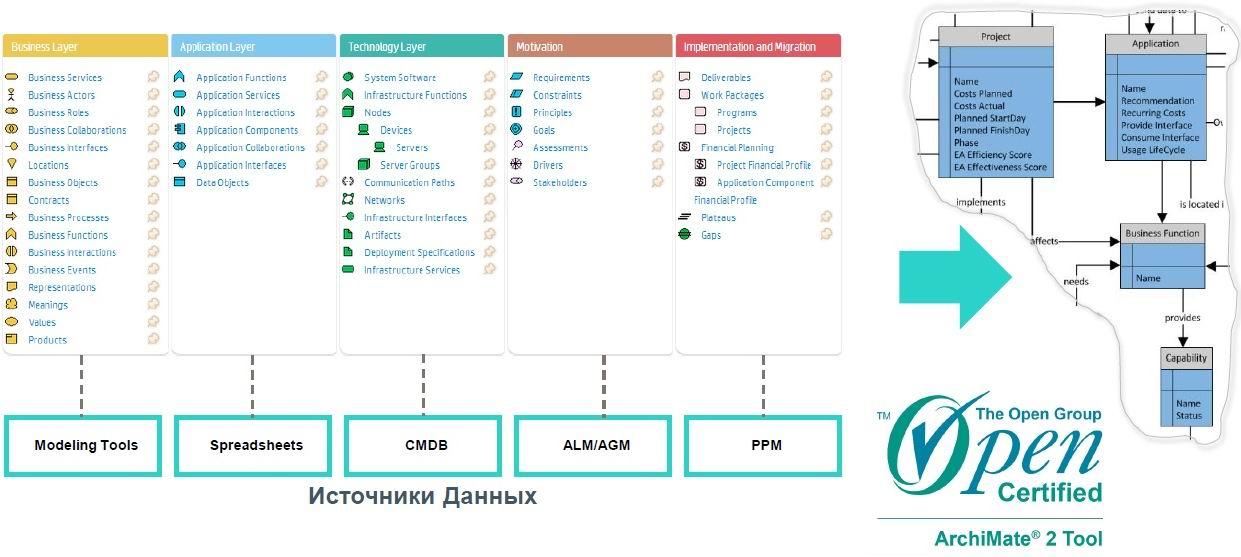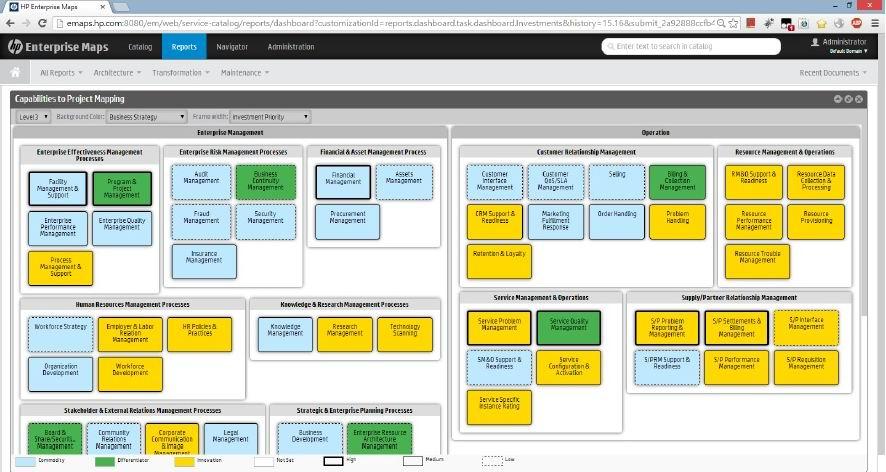Enterprise Architecture - a strategic approach to IT
 What is the problem of all Russian companies without exception? A business has its own understanding of what is happening, its requirements and tasks, but it is very difficult to shift them to the language of specific IT actions, and these requirements do not always reach IT in a clear form.
What is the problem of all Russian companies without exception? A business has its own understanding of what is happening, its requirements and tasks, but it is very difficult to shift them to the language of specific IT actions, and these requirements do not always reach IT in a clear form.The second traditional problem is inherited IT. In the past years, a lot of chaotic purchases and implementations were made, which creates a great complexity of the IT landscape. Any IT manager who comes to the company takes a lot of time to understand the situation. On the other hand, a business invests in IT money and wants to see where it goes, what projects and initiatives, and how it moves the company toward strategic goals.
In Russia, the direction of corporate architecture is not yet developed. Companies are in great demand to develop architectures of specific solutions, but nobody seriously deals with the linking of architecture components within an organization. At best, spreadsheets are used for this purpose, where information is stored in an unformalized form, and when a manager leaves the company, knowledge goes with it.
The most important consequence of this approach is the non-optimal spending of funds on IT, sometimes even their direct waste. That is why overseas companies are increasingly demonstrating a strategic approach to IT management, and the vector is increasingly leaning towards streamlining and standardizing corporate IT landscapes.
')
Words - in action
The problem is obvious: it is necessary to connect the business with IT, to build a bridge between them, ensuring transparency. The strategy must be shifted to the demands and actions that need to be brought to people. Each unit must understand the essence of the work and the general direction of IT development.
To solve this problem, the system is HPE Enterprise Maps. What is important, is the company's own development, and not an acquired solution, which has recently become rare. This is good: HPE, as a system supplier, has reached an understanding of what is needed and necessary in the market, and took the initiative to develop such a product. Being proprietary, Enterprise Maps seamlessly interacts with other HPE systems and is enriched with data from them, turning into a holistic, powerful solution.

In order not to reinvent the wheel, Enterprise Maps uses the TOGAF methodology, which is understandable to architects and shows how to approach the management of corporate architecture. The ArchiMate 2.0 notation is used as a language for describing the interaction of architecture elements with each other.
The main tasks of the developed system are to reduce the risks and confusion associated with IT, to ensure compliance with the IT strategy. It is extremely important to be able to shift “beautiful” words into concrete actions. In addition, meaningful management of the “zoo” of existing systems is becoming a non-trivial task: there are a lot of suppliers on the market with their own licensing policies, product updates and old solutions out of circulation.
Practically in any company you can find software that has paid support, although it is not really needed or — moreover, the system has already been removed from support. It happens and vice versa: the company plans to build a new system, not realizing that the platform used is very outdated.
For IT and business
Who might be interested? If the company has such a position as a corporate architect, then it will become the main stakeholder.
Usually to describe the architecture used by the program- "paint" - for example, Microsoft Visio. It is important to note that Enterprise Maps is not drawing, but the creation of models related to the real world, and during their development, compliance with various policies will be monitored. It is impossible to create an object divorced from reality.
Architects - an audience that understands the advantages of the system and is able to appreciate its capabilities. However, unfortunately, they often do not manage budgets, and decisions will be made above.
The next important group of users are financial managers and CIOs. They have other tasks. Say, the CFO may not understand too much what is happening in IT, but it is important for him to see where the investments are going and how much priority this area is in terms of strategy. He will receive information about this not in the form of a report edited by employees, but with the help of a real cut of the information. For a CIO, the transparency of the IT department’s activities and the additional rationale for their decisions to top management are important.

Of course, big business is interested in the decisions of such a class that has reached a certain maturity - people who understand that it is necessary to bring order to the economy. What is very important, Enterprise Maps, as opposed to heavier solutions that require a fundamental approach, suggests the path of “quick wins”: promptly implement a separate scenario to prove yourself, and then gradually build up the power of the solution.
For example, in the system, the “Five steps for moving an application to the cloud” is “sewn up”. Having such ready-made scenarios is very important for implementing quick projects that show business the benefits of the solution.
Not only reporting
There are three typical directions that Enterprise Maps covers. The first is to combine the available data (architecture models, business strategies) into a single repository, where all elements are related to the corporate architecture, identify people responsible for information cuts, and synchronize with various data sources.
Secondly, seeing the current situation, you can build a plan for the transition to the target state, determining the missing elements with the help of Gap-analysis. This is the key difference between the solution and the configuration management database (UCMDB), reflecting only the current situation and only at the infrastructure level. The third important area is the standardization of the approach to IT assets, systems and functions.
At the output of the system, the company receives information slices for various users. Each of them will see the information in which he is interested. With the help of Enterprise Maps, you can answer a variety of questions: for example, you can find out how much the content of an application is costing, whether an investment is in line with the strategy, where the money goes, which is possible with the allocated budget.

Usually, having seen the capabilities of Enterprise Maps, many people ask: is this a reporting system? Yes, the similarity is great. But the solution is not just responsible for presenting data in a beautiful graphical form, but also becomes the main working tool of the architect - a means of creating and maintaining enterprise architecture models.
It is important that inside the system, you can lay out the development policy of the architecture (both the infrastructure part and the applications) that will be monitored. Prohibited actions will not work, and further compliance with the rules will be rechecked. Thus, the architect does not just “draw pictures”, but quite deliberately approaches to solving problems.
Data sources
In order for the system to be operational, it must be filled with data. This can be done easily with the help of Excel spreadsheets and files, and this is enough for most customers - it is in this form that information about the corporate architecture is usually stored. More advanced customers have UCMDB systems, which also become a valuable source of data.
Another important source is the project portfolio management system. From here come goals, programs, projects. Based on this data, it is possible to show the place of the projects being implemented in the overall strategy.
Finally, for filling systems one cannot do without modeling tools - for example, Sparx Enterprise Architect, one of the most popular systems due to its low cost. Moreover, in some cases the use of such specialized means is preferable. If a new system is being developed, becoming a major element of the architecture, it is better to take design tools designed for this and familiar to users, then load the built models into Enterprise Maps, where they will be connected with current systems, infrastructure, plans and project activities.
Objective picture
An important part of the system is embedded reports - information slices, which become a valuable source of knowledge when making decisions about IT development. Among them are several key.
One of them is the report “Business Opportunities of the Application Portfolio”. Based on his data, it can be said where the company should invest in accordance with its strategy, highlighting strategically important decisions, or vice versa - to identify candidates for the transition to the cloud. The next step is to identify critical business applications that support key processes and therefore require special treatment.
The “Strategic Investments” report allows you to see the gaps between real investments and business priorities. For example, on the basis of financial information from the project portfolio management system, one can determine excessive investments in non-priority areas. This gives the financial transparency that the business wants to see. A review of application costs also provides food for thought about their business value and the actual costs of them.

Platform Utilization is a report that can also be very useful. It allows you to understand, for example, that a third of applications use an unsupported platform, and if you plan to introduce a new system, you should think about it.
One of the most important features is the creation of a “dependency tree” that shows the relationship between specific infrastructure elements and business services. There are frequent situations when the work of a business-relevant system is supported by a single server, which reduces its fault tolerance, or vice versa — an uncritical application runs on unreasonably expensive hardware.

Order cleaner
Quite mature financial organizations can be distinguished among the most interested in corporate architecture of companies. The reasons are obvious: they constantly have to be “on advanced IT”, capturing new markets, which is reflected in the IT architecture. They need transparency much more often, including in the process of achieving goals. Finally, in the financial sphere, competition is extremely high, and major mistakes in IT can be costly.
Do not think that corporate architecture management systems are solutions exclusively for giants. If you manage to show business that there are platforms for which you can not pay for a long time, or business requirements that are not given enough attention, the result can be very impressive even with a small company.
Nevertheless, a reasonable limit on the size of the company still exists. Minimum purchase - 10 licenses, that is, the organization must have at least 10 people who are interested. A few architects - this is quite a large organization.
But the main thing is that the company should be ready, having bought in the past years a lot of equipment and applications, to bring order to its IT industry. There are so few.
Source: https://habr.com/ru/post/300478/
All Articles